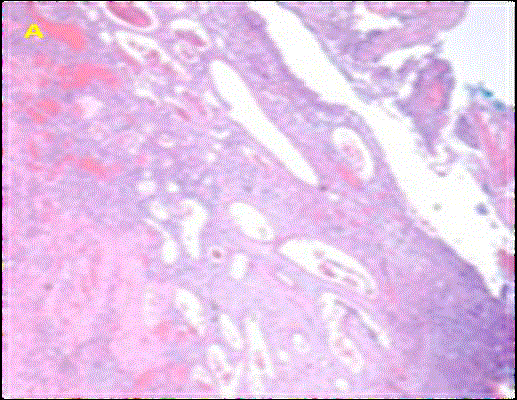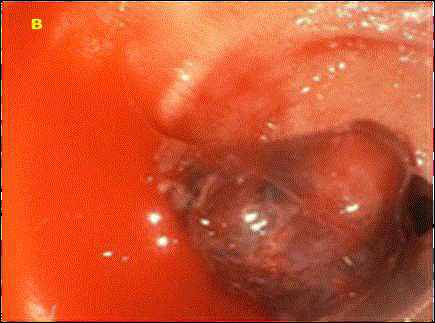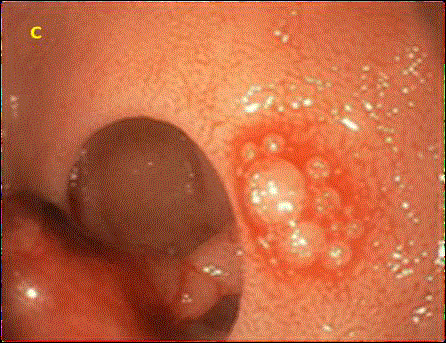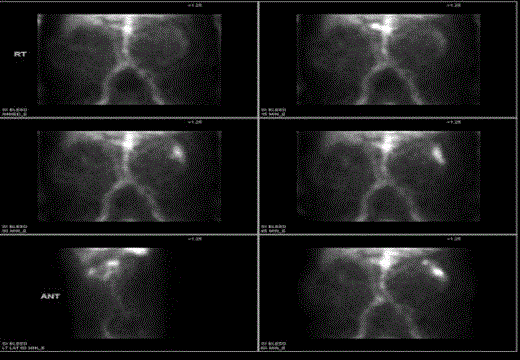Case Report
Abnormal Localization by Tagged RBC Scan in a Patient with Duodenal Polyp Presenting with Gastrointestinal Bleeding
Abhilash Perisetti*
Department of Family and Community Medicine, Texas Tech University Health Sciences Center, Texas 79430,
USA
*Corresponding author: Abhilash Perisetti, Department of Family and Community Medicine, Texas Tech University Health Sciences Center, 3601 4th Street, Stop 8143, Lubbock, Texas 79430, USA
Published: 07 Aug, 2017
Cite this article as: Perisetti A. Abnormal Localization
by Tagged RBC Scan in a Patient
with Duodenal Polyp Presenting with
Gastrointestinal Bleeding. Clin Surg.
2017; 2: 1587.
Abstract
An 87-year-old man with a history of prior Billroth II surgery for bleeding peptic ulcer presents with melanic stools from outside hospital (OSH). A radionuclide study (tagged red blood cell, TRBC scan) was performed which showed active colonic bleed for which a colectomy was offered, but the patient refused. He was transferred to our facility for an alternative procedure. A CT angiogram was performed which did not show any extravasation. This led to an EGD which showed a duodenal polyp, for which snare cautery polypectomy was performed. Biopsy reviewed a benign polypoid duodenal vascular malformation. Due to the false localization of left-sided colonic bleed, a colonoscopy was performed which only showed conducted blood from the possible source being a duodenal polyp.
Introduction
TRBC scan is a technique which uses a small quantity of radioactive material to tag the RBCs [1]. The body is then scanned to visualize the cells and track how they circulate in the body. It has a limited but unique role in the evaluation of overt gastrointestinal bleed. It is performed to localize the site of bleeding especially when the bleeding rate is 0.1 to 0.5 mL/ minute [2]. Indication for this technique is when endoscopy fails to identify a definite source of bleeding, in which case, it aids in the localization of bleeding [2]. However, the result of the test is significant only when interpreted in conjunction with the clinical scenario. We present a case where a patient was offered total colectomy at an outside facility solely based on the tagged RBC scan being suggestive of a major colonic bleed, however, the bleeding was from a duodenal polyp.
Case Presentation
An 87-year-old man with a history of Billroth II surgery for bleeding peptic ulcer in the 1980's was transferred from OSH for evaluation of gastrointestinal bleed. He presented with melanotic stools for three weeks. At OSH, a red cell tag scan was performed which localized the bleeding in his left upper quadrant. For reasons not known, an endoscopy was not performed (Figure a and b). Colectomy was offered, but the patient refused surgery and was transferred to our facility for evaluation and a possible alternative, transcatheter embolization. A CT angiogram of the abdomen was done which did not show any active extravasation, so no embolization was performed. An EGD was performed which revealed Billroth II anatomy and a bleeding polyp in the duodenum of about 2cm with a thick stalk in the afferent limb. Snare cautery polypectomy was performed after prophylactic deployment of the hemo-clips over the stalk. The pathology showed a benign polypoid duodenal vascular malformation. TRBC scan performed from OSH was reviewed with radiology which showed two areas of tracer activity. One was near the mid abdomen which corresponded to the site from where the polyp was removed (Figure c and d). The other was in the left upper quadrant suspicious for a simultaneous colonic bleed. Colonoscopy was performed the next day which showed conducted melanic stool in the splenic flexure with no evidence of any active bleeding.
Figure A
Figure 2
Figure C
Figure D
Discussion
Tagged Red Cell Scan (TRBC) has many merits including being cheap, non-invasive, requiring minimum preparation, detecting bleeding as low as 0.1mL/min to 0.5mL/min, and the capability of detecting intermittent bleeding over a prolonged period with repeated imaging [3]. Its limitation includes non-localization of site precisely and erroneous localization of bleeding due to poor spatial resolution, operator dependency, the pool of blood moving with the peristalsis, or if the position of the patient changes while performing the procedure [4]. As per ASGE practice guidelines for overt obscure GI hemorrhage: The technetium 99m-labeled red blood cell scan is used most commonly in the actively bleeding patient in whom no source has been identified on EGD or colonoscopy [2]. These scans can aid in the localization of bleeding that can then be verified with repeat endoscopy, angiography, or surgery [5]. An early blush appears to be more accurate than delayed positivity in lower GI hemorrhage. Although sensitive, nuclear medicine scans can identify only a general area of bleeding and are very limited regarding directing treatment [6]. Results from studies of technetium-labeled red blood cell scintigraphy vary widely and may reflect differences in patient selection as well as the timing of the study about clinical presentation [6]. TRBC scan is less sensitive in detecting and correctly localizing active bleeding in foregut (33% detection) compared to the colon (75% detection). Another study of 103 patients with GIB, scintigraphy failed to localize hemorrhage in 85% of cases and was a poor predictor of a positive angiographic study [7]. In our case, the bleeding happened in the duodenal area which was picked up by the tag scan, but due to the more prominent second tracer activity (by the conducted bleed in the colon), it led to the interpretation of a colonic source. This case indicates the role of using the TRBC scan in conjunction with clinical presentation and endoscopy to accurately localize the site of lesion rather than single diagnostic modality.
References
- Zuckier LS. Acute gastrointestinal bleeding. Semin Nucl Med. 2003;33(4):297-311.
- Gurudu SR, Bruining DH, Acosta RD, Eloubeidi MA, Faulx AL, Khashab MA, et al. The role of endoscopy in the management of suspected small-bowel bleeding. Gastrointest Endosc. 2016;85(1):22-31.
- Nicholson ML, Neoptolemos JP, Sharp JF, Watkin EM, Fossard DP. Localization of lower gastrointestinal bleeding using in vivo technetium-99m-labelled red blood cell scintigraphy. Br J Surg. 1989;76(4):358-61.
- Dusold R, Burke K, Carpentier W, Dyck WP. The accuracy of technetium-99m-labeled red cell scintigraphy in localizing gastrointestinal bleeding. Am J Gastroenterol. 1994;89(3):345-8.
- Gutierrez C, Mariano M, Vander Laan T, Wang A, Faddis DM, Stain SC. The use of technetium-labeled erythrocyte scintigraphy in the evaluation and treatment of lower gastrointestinal hemorrhage. Am Surg. 1998;64(10):989-92.
- Tabibian JH, Wong Kee Song LM, Enders FB, Aguet JC, Tabibian N. Technetium-labeled erythrocyte scintigraphy in acute gastrointestinal bleeding. Int J Colorectal Dis. 2013;28(8):1099-105.
- Howarth DM. The role of nuclear medicine in the detection of acute gastrointestinal bleeding. Semin Nucl Med. 2006;36(2):133-46.




